Claim coat of arms on coins
here Part 2
Part 1: Claim coat of arms, initiation Part 3: Claims on Jülich-Kleve-Berg
|

Charles I of Anjou, 1266-85: Salut d'or, Naples. Ø 22 mm, 4,37 g. CNI 19 p.13 n.1; Pannuti/Riccio 1; Friedb.808. Obv: +KAROL·DEI·GRAtia·IERosoLymoruM·SICILIE·RE(X) "Charles, by the grace of God, King of Jerusalem and Sicily" Split coat of arms: Jerusalem and Anjou (lilies), between a sickle, two rosettes and four stars. Rev.: +AU(v)E Maria·GRACIA·PLENA·DOMINUS·TECUM "Hail Mary, full of grace, the Lord is with you" Annunciation: Archangel Gabriel points to the Virgin Mary, vase with lilies in between.

Alfonso V. of Aragon as Alfonso I. of Naples : Carlino Naples. Ø 26 mm, 3,59 g. Pannuti Riccio 42, 3 var.; CNI XIX 76, 191 var. Obv.: ✠ALFOnSVS◦D◦G◦Rex◦ARagon◦Siciliae◦ᗡitra et◦Vltra◦Faro "... Sicily, on both sides of the strait" Quartered coat of arms Aragon / Naples (Jerusalem/Anjou/Hungary). Rev.: ✠DnS◦ᙏ◦ADIVT◦ᗺ⦂ᗺGO⦂D◦I◦ᙏ for "Dominus mihi adiutor et ego despiciam inimicos meos" = "The Lord is my helper and I will look down on my enemies" (Ps.118,7). The king holds a scepter and cross globe and sits on lions as a throne. Further coins and medals with the portrait of Alfonso I, King of Naples.
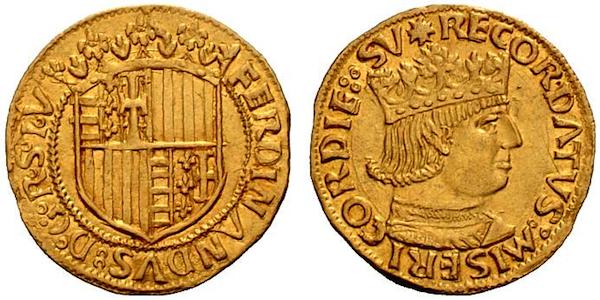
Ferdinand I of Aragón, 1458-1494, King of Naples. Ducato, Naples. Ø 22 mm, 3,54 g. CNI 24var; Pannuti Riccio 5. Obv.: FERDINANDVS:Dei°Gratia°Rex°Siciliae°Ierosolymarum°Vngaria Coat of arms: Hungary-Anjou-Jerusalem | Aragon Rev.: + RECORDATVS:MISERICORDIE:·SV "In memory of his mercy" From now on, no Anjou-lilies any more. 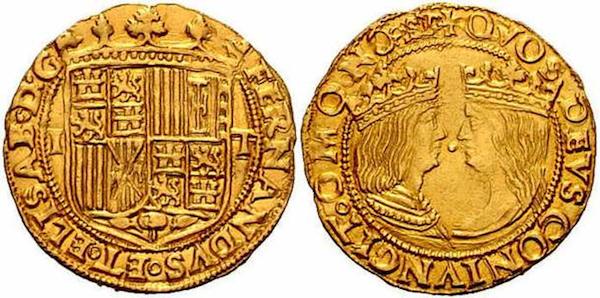
Ferdinand II of Aragon and Isabella of Castile, 1503-04, as kings of Naples and Sicily.. Ducato, Naples. Ø 22 mm, 3,48 g. CNI 6; Pannuti Riccio 1. FERNANDVS◦ET◦ELISAB◦D:G // + QVOS - DEVS CONIVNGIT◦hOMO&◦NOn◦SEParet "Those whom God has given together, man shall not separate" Top right the coat of arms of Naples: Aragon|Jerusalem|Hungary.
Like the Catholic Kings, Emperor Charles V also allowed his claims to Jerusalem to live on,
e.g. on a undated scudo from Naples.
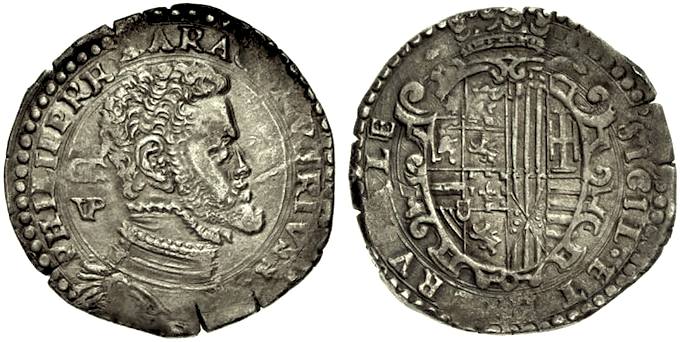
Philip II., 1554/6-1598, King of Spain, Naples and Sicily. 1/2 Ducato n. d. (1570), Naples. mintmark GR/VP. Ø 34 mm. Pannuti/Riccio 15b. PHILI(I)P REX ARAGON VTRIVSque // SICILia·ET HIERVSALEm Coat of arms, top right : Aragon|Jerusalem, and bottom right : Sicily|Hungary.
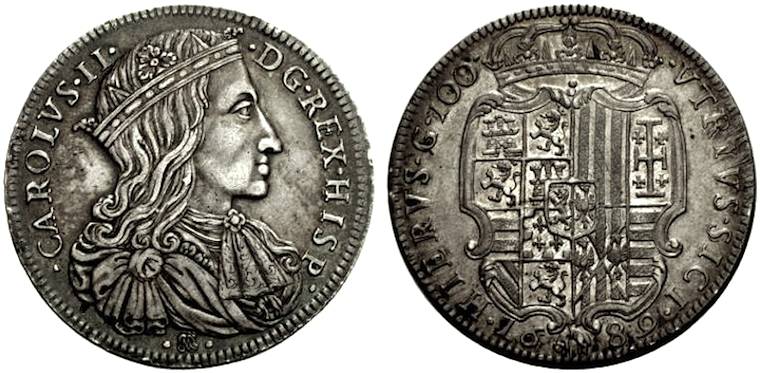
Charles II, 1665-1700, King of Spain, Naples and Sicily Ducato (100 grana) 1689, Naples. Ø 41 mm, 24,44 g. Pannuti/Riccio 2; Dav.4046. Obv.: ·CAROLVS·II· - ·Dei Gratia·REX·HISPaniarum· Rev.: ·VTRIVSque·SICIliae· - 16-89 - ·HIERVSalem·Grana·100· - Heart coat of arms: Flanders|Tyrol. After the Spanish Habsburgs died out and the subsequent War of Succession, Naples came to Austria. 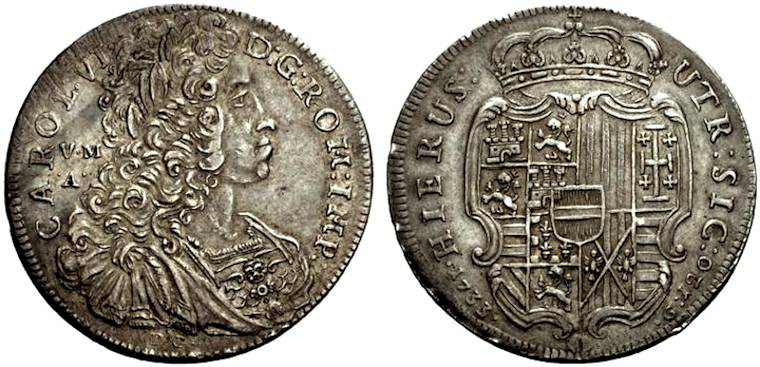
Charles VI of Austria, 1707-1734 (Naples) & 1720-1734 (Sicily) Piastra da 120 grana 1733, Napoli. Ø 41 mm, 25,37 g. CNI 46; Pannuti Riccio 2; Dav.1396. CAROL.VI. - D:G:ROM:IMP. // UTR:SIC: - HIERUSalem: & 1733 - .G:120 In 1735, the Spanish Bourbons took over Naples and Sicily from the Habsburgs of Austria and continued to use the Jerusalem title, but not the coat of arms. |
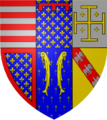
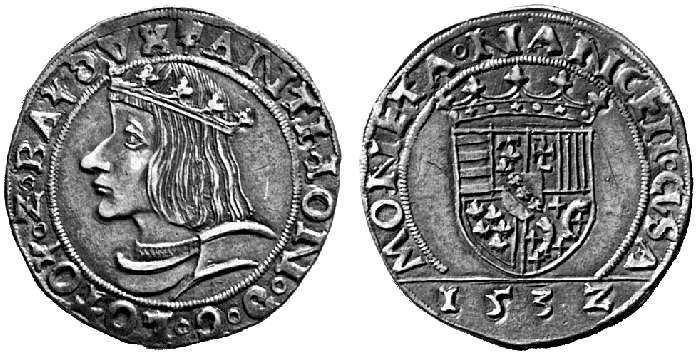
Anton the Good, 1508-44, Duke of Lorraine: Teston 1532, Nancy. Ø 29 mm, 9,39 g. Obv.: ‡ANTHON◦D◦G◦LOTOr◦Z◦BAr DVX "... Duke of Lorraine and Bar" Rev.: MONETA◦NANCEII◦CVSA "Money struck in Nancy" coat of arms, above: Old Hungary, Anjou-Naples, Jerusalem, Old Provence (= Aragón) below: Anjou (framed lilies) and Bar (2 fish between crosses). Heart coat of arms: Lorraine (sloping bar with three mutilated eagles). Coats of arms of possessions are only those of Lorraine and Bar.
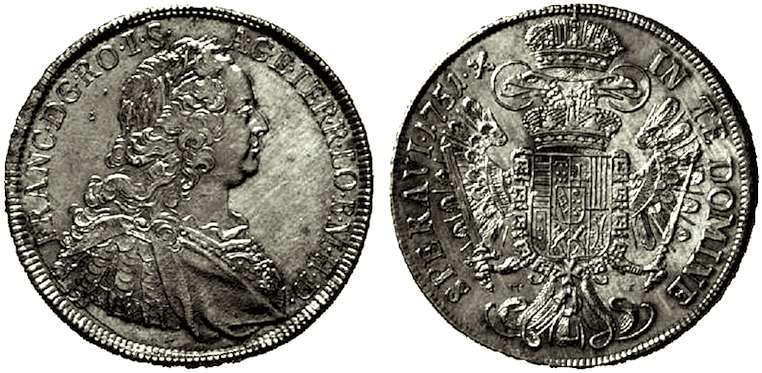
Emperor Francis I., 1745-65. Thaler 1751 W-I, Vienna. Ø 41mm, 832 fein, 28,08 g. Voglh.289; Dav.1152. Obv.: FRANCiscus·Dei·Gratia·ROmanorum·Imperator·Semper· - Augustus·GErmaniae·IERodolymarum·Rex· LOtharingiae·Burgundiae·Magnus·Hetruriae·Dux· "Francis, by the grace of God Roman Emperor, perpetual ruler, King of Germany and Jerusalem, Duke of Lorraine and Burgundy, Grand Duke of Etruria (Tuscany)" Armored and draped bust with laurel wreath and fleece order as a brooch on the chest. Rev.: IN TE DOMINE - SPERAVI·1751·X (X = St. Andrew's Cross) "I have placed my hope in you, Lord" Crowned double-headed eagle with sword and scepter, crowned coat of arms on the chest: Coat of arms, above: Old Hungary, Anjou-Naples, Jerusalem, Aragon Coat of arms, below: Anjou, Geldern, Jülich, Bar (2 fishes between crosses) Heart coat of arms: Lorraine | Tuscany (6 pills) Below the shield with the coats of arms is the Tuscan cross of Saint Stephen. The Order of the Fleece chain is placed around the shield. In the field next to it: W - I for the Vienna mint. Raised border inscription: PRO DEO ET IMPERIO and decorations. |
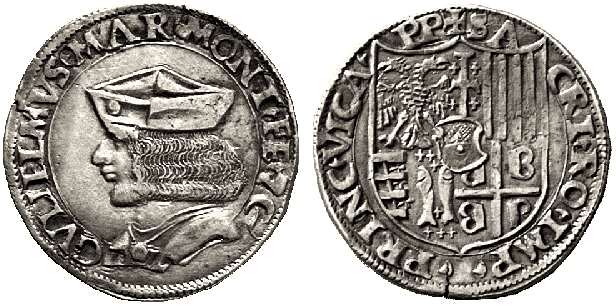
Guglielmo (William) II Palaiologos, 1494-1518, Margrave of Montferrat Testone n. d. Ø 29 mm, 9,51 g. CNI II,p.106,no.32 Obv.: GVLIELMVS*MAR*MONTFE*7C "Wilhelm, Markgraf von Montferrat, etc." (7C = et cetera) Rev.: +SA - CRI·ROmani·IMPerii·PRINCeps·VICArius· - PerPetuus "Prince of the Holy Roman Empire, Permanent Governor" Coat of arms above: Byzantine Empire, Jerusalem, Aragon; below: Saxony (!), Bar, Palaiologists (cross and 4 Bs). Heart coat of arms: Montferrat. The subsequent dynasty - the House of Gonzaga - also incorporated Jerusalem into its coat of arms,

Ferdinand Gonzaga, 1612-1626, Duke of Mantua and Monferrat Tallero n. d., Casale. Ø 41mm, 22,10g. Dav.3870 Vs.: ·FERDINANDVS - D·G·DVX·MAN·VI· Rs.: ET·MONTIS❀·❀FERRATI·IV·❀ - Coat of arms of Jerusalem "Ferdinand, by the Grace of God 6th Duke of Mantua and 4th Duke of Montferrat"
|
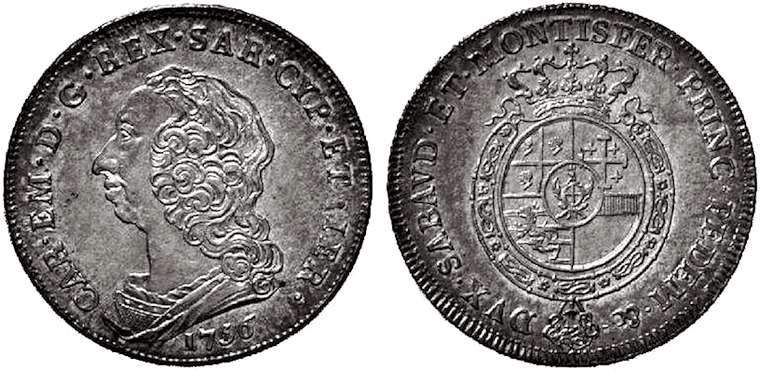
Carlo Emanuele III., 1732-73, Duke of Savoy and King of Sardinia Scudo da sei lire 1756, Torino. Ø 43 mm, 35,18 g. Dav.1494. Obv.: CARolus·EManuel·Dei·Gratia·REX·SARdiniae·CYPerae·ET·IERosolymarum 1756 "Carlo Emanuele, by the grace of God, King of Sardinia, Cyprus and Jerusalem" Rev.: DVX·SABAVDiae·ET·MONTISFERratum·PRINCeps·PEDEMonti·&· "Duke of Savoy and Montferrat, Prince of Piedmont" Crowned oval coat of arms with attached Order of Annunciation, quarteres coat of arms: Sardinia, Jerusalem (top right), Lusignan, Montferrat (bottom right) Heart Shield: Savoy. |
Part 1 : Claim coat of arms, initiation Part 3 : Claims on Jülich-Kleve-Berg
 Start page
Start page Gottfried of Bouillon, Duke of Lorraine since 1089, set off on the First Crusade in 1096. After the conquest of Jerusalem in 1099, he became the first regent of the newly founded Kingdom of Jerusalem. After his death in 1100, his brother was proclaimed King Balduin I of Jerusalem. After the death of Balduin II, his son-in-law Fulko, Count of Anjou, took over Jerusalem in 1131. He was succeeded on the throne by two sons and a grandson.
Gottfried of Bouillon, Duke of Lorraine since 1089, set off on the First Crusade in 1096. After the conquest of Jerusalem in 1099, he became the first regent of the newly founded Kingdom of Jerusalem. After his death in 1100, his brother was proclaimed King Balduin I of Jerusalem. After the death of Balduin II, his son-in-law Fulko, Count of Anjou, took over Jerusalem in 1131. He was succeeded on the throne by two sons and a grandson.



